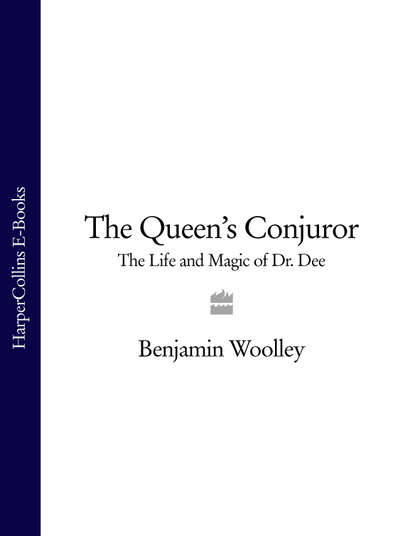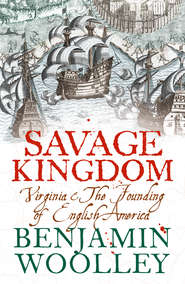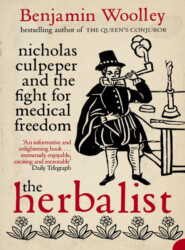По всем вопросам обращайтесь на: info@litportal.ru
(©) 2003-2024.
✖
The Queen’s Conjuror: The Life and Magic of Dr. Dee
Настройки чтения
Размер шрифта
Высота строк
Поля
There is official record of the moment John Dee entered the world. He is not listed in any parish register or private correspondence. There is no birth certificate or diary entry. There is only a series of numbers, a cosmic coordinate: 1527 July 13 4
.2’ P.M. Lat. 51°.32’.
The data are inscribed on a mysterious document among his papers at the Bodleian Library in Oxford.
(#litres_trial_promo) A square containing a series of numbers and astrological symbols is sketched on parchment. It is a horoscope, drawn up in the ancient manner, showing the heavens at the precise time and place of Dee’s birth.
He was born at 4.02pm on 13 July 1527. His birthplace was 51 degrees and 32 seconds north of the equator, roughly the latitude of London.
(#litres_trial_promo) Latitudes, which specify how far north or south a location is on the earth’s surface, were absent from maps of early or mid sixteenth-century England (there were barely any maps anyway; the earliest to survive of London is dated 1558).
(#litres_trial_promo) However, the information could be found in tables of astrological data. One set compiled by Dee is to be found among his papers; it identifies the location of cities and landmarks across the world, from Paris (49° 10’, 150 miles from London) to the ‘Lake of Sodome’ (31° 10’, 2,404 miles from London).
(#litres_trial_promo) In that table, Dee gives London’s latitude as that shown on his birthchart, which – according to modern measurement – falls just outside the wall marking the city’s northern limit.
Following contemporary practice, Dee did not record the longitude of his birthplace. There was no standard meridian at the time, and the methods of measuring longitude were extremely unreliable. However, from the date and the position of the Sun plotted on the birthchart, it is evident that Dee’s birthplace was within a few degrees of the modern Greenwich meridian. The most likely location for Dee’s birth is the City itself. His father Roland, of Welsh descent, was a textile merchant and member of London’s powerful guild of ‘mercers’. His mother Jane, was the daughter of William Wild. Roland married her when she was fifteen. Born three years after the wedding, John was apparently their first and only surviving child.
(#litres_trial_promo)
Roland was recorded as being resident in Tower Ward, the area immediately west of the great Tower of London, and within sight of Tower Hill, where, as the Tudor surveyor John Stow put it, ‘is always readily prepared at the charges of the city a large scaffold and gallows of timber, for the execution of such traitors and transgressors as are delivered out of the Tower’.
(#litres_trial_promo)
In later years Roland would find himself a ‘transgressor’ and spent time in the Tower. But in the 1520s, he was on the threshold of a promising career, which drew him in the opposite direction, towards the City’s teeming square mile.
Many merchants in Tower Ward lived along Thames Street, close to Billingsgate Docks, where the quays bustled with barques and barges bringing herring, wine, wool and timber into the capital. Next to Watergate, which was a lane leading up from the river, stood ‘Wool Wharf’, which had been used for the ‘tronage’ – public weighing – of wool imports ever since the reign of Richard II.
(#litres_trial_promo) Roland Dee was later to perform a similar job, so he and his son were likely to have visited, and may have even occupied, the rickety riverside house, as bulbous packets of wool were heaved into its weighing room and dropped on the official scales or ‘tron’.
East of Thames Street lay the imposing parish church of St Dunstan’s. Its fabric was lavishly maintained by local merchants, whose bequests were rewarded with opulent sepulchres in its nave and cemetery. Dunstan was then one of England’s most revered and popular saints (another church is named after him in the west of the city). Much associated with Glastonbury and early British nationalism, his name would feature prominently in the life of the boy who was being brought up within the church’s precincts.
(#litres_trial_promo)
Surrounding St Dunstan’s were bustling inns and narrow streets whose very names spelled commerce: Lombard Street, just north of the church, named after the merchants of Northern Italy who settled there in the twelfth century; the Three Cranes, which got its name from a timber crane used to unload lighters loaded with casks of Bordeaux, and the chosen venue for French tradesmen brokering deals with English vintners; Threadneedle, Milk and Friday Street, where tailors, dairymen and fishmongers plied their trades; Cheapside, the thoroughfare for London’s main market or ‘cheap’ which was lined with grocers and apothecaries; Ironmongers Lane, where among the clanking wares hanging from shopfronts, Roland would go to meet his fellow Mercers at their handsome Hall.
(#litres_trial_promo) This was the world that shaped Dee’s formative years: a place filled with the babble of foreign tongues and complex numbers, of ready ‘reckonyngs’ and tricky deals.
However, the City was not the only focus of Roland Dee’s career, and it is just possible that John was born just a few miles up the Thames, on the Greenwich meridian itself. Greenwich Palace stood on the bank of the Thames, Greenwich Hill rising up behind.
(#litres_trial_promo) It was King Henry VIII’s birthplace and his main residence. Roland had a position in Henry’s court as a ‘gentleman sewer’.
(#litres_trial_promo) His role, like so many court positions at the time, hovered between the ceremonial and the functional. It is unlikely Roland would have been expected to stitch the King’s clothing, but he may have been involved with buying and maintaining the innumerable fabrics that furnished the King’s palaces and person.
That summer of 1527, events were taking place within the confines of Henry’s private apartments at Greenwich which would prove momentous in English and European history. Just three weeks before John Dee’s birth, the King, desperate both for a male heir and to consummate his infatuation for Anne Boleyn, accosted his wife Catherine ‘in her closet’ and, reviving arguments about their union violating Biblical law, suddenly announced that their marriage was invalid.
(#litres_trial_promo)
In the drama that followed, a key role was played by a colleague of Roland’s, another gentleman sewer in Catherine of Aragon’s retinue, Felipez. Catherine was desperate to get news of her predicament back to her nephew and Catholic guardian, Charles V of Spain, the Holy Roman Emperor and most powerful monarch in Europe. She told Felipez to go to Henry and protest that the Queen had cruelly refused him passage home to Spain, where his mother was dangerously ill. Catherine knew Henry would contradict her and dispatch the apparently disgruntled servant back home, where he could then make contact with Charles.
However, Henry was prepared for such ‘dissimulation’ and ‘did also dissimulate’. He granted Felipez a licence to leave the country while arranging for agents to waylay him en route. But Felipez managed to give them the slip and reach the Emperor at Valladolid, where he broke the news of Henry’s plan.
(#litres_trial_promo) These revelations precipitated Henry’s break with Rome and the turmoil of the Reformation, seismic events that would shape English politics for generations to come, and bring danger and conflict into the life of the infant son denied to Henry and Catherine, but so recently born to Roland and Jane.
While the world around was in turmoil, the heavens above presented a picture of serene certainty. Standing in the pastures and playing fields that surrounded the City’s walls, gazing at a vivid canopy of stars yet to be diminished by light or atmospheric pollution, John Dee beheld a universe that had apparently remained unchanged since the Creation.
Common wisdom was that the earth stood at the centre of the cosmos; the sun, the moon and the planets revolved around it, fixed to the perimeters of a series of concentric spheres. The outermost sphere carried the stars, and beyond lay heaven. Historians of science call the modern view of the universe mechanistic, but the ancient one was as mechanical as a clock. In a state of constant movement, the system was regulated by immutable laws. Change was possible only within the space between the earth’s surface and the orbit of the moon. This was the sphere of fire and air, the domain of such ephemeral astronomical phenomena as comets and meteors.
Where the modern universe is infinite, the size and age of this nest of glistening orbs was far more modest. Genealogies in Genesis and elsewhere in the Bible showed it to be less than six thousand years old. As for its size, the fifteenth-century printing pioneer and encyclopaedist William Caxton wrote:
If the first man that God formed ever, which was Adam, had gone from the first day that he was made and created twenty-five miles every day, yet should he not have comen thither, but should yet have the space of seven hundred and thirteen year to go at the time when this volume was performed by the very author. Or if there were a great stone which should fall from thence unto the earth it should be an hundred year ere it came to the ground.
(#litres_trial_promo)
This, then, was the cosmos that Dee beheld: stable, fixed and finite. There were disputes over details, but the overall view had not changed significantly since the Egyptian astronomer Claudius Ptolemy had established the mathematical laws by which the universe operated in the second century. Ptolemy had invented a series of hypothetical entities such as ‘epicycles’, ‘deferents’ and ‘equants’ which made it possible to work out with a high degree of accuracy not just the motions of the planets in the past, but their positions into the distant future, accounting even for such astronomical gymnastics as retrograde motion, when a planet appears to stop, backtrack, and then continue onwards.
Many tables of planetary positions were compiled using Ptolemy’s formulae. These showed how each planet moved in relation to the stars, in particular the constellations of the zodiac. Such almanacs or ephemerides were among the most popular books to be produced in these early days of printing, and Dee would eventually accumulate more than fifteen different sets in his library. It was one of these that he used to work out his birthchart.
Exploiting the mathematical nature of these heavenly motions, he could plot the positions of the planets at the moment of his birth with far more certainty and precision than the flapping scholars his father passed in the Greenwich Palace corridors could determine the legitimacy of Henry VIII’s matrimonial manoeuvres.
Birth charts are now circular, but Dee’s was drawn up as a square, a form which went back to the ancient Egyptians. The information it contains is very similar to that of a modern chart, except that the as yet undiscovered planets Uranus, Neptune and Pluto are missing. Dee managed to map the position of each heavenly body in the sky to within a few minutes of arc (a minute being one-sixtieth of a degree), with the exception of Mercury, nearly two degrees adrift. The ascendant, which marks the position of the sign of the zodiac rising on the eastern horizon, is out by almost one degree.
The twelve triangles represent the most synthetic elements of any birthchart, the position of the ‘houses’. These are purely astrological (as opposed to astronomical) entities, determining how the planets influence the subject’s appearance, temperament, property, relationships and so on. As the signs of the zodiac are tied to the rotation of the celestial sphere, the houses are tied to the rotation of the earth, the two becoming enmeshed by the moment of birth.
Dee left no interpretation of his own chart. He rarely committed his findings to writing. Such works could be dangerous, particularly when the subjects were of aristocratic or royal status, which many were. Dee’s only interpretation of any length that survives concerns his pupil, the glamorous poet and soldier Sir Philip Sidney, for whom Dee drew up a sixty-two page nativity which made several tentative predictions. He foretold that Sidney would enjoy a wonderful career between the ages of fifteen and thirty-one. Then he faced mortal danger from a sword or gunshot injury which, if survived, would inaugurate even greater glories and a long life. Sidney was killed in battle in the Low Countries on 17 October 1586, aged thirty-one.
(#litres_trial_promo)
Dee’s own chart depicts similar tensions. The two most powerful influences, the Sun and the Moon, the two ‘luminaries’, are in opposition – a common enough configuration, but one that suggested conflict. More notable was the position of Jupiter, which basked with the Sun in the ‘serene and warm’ sign of Cancer, where it was exalted. In his copy of Ptolemy, he marked the observation that Jupiter’s distance from the ascendant (the sign rising on the eastern horizon) indicated that he would be skilled in philosophy.
(#litres_trial_promo) ‘If he should be lord alone,’ Ptolemy had written, Jupiter would also promote ‘honour, happiness, content and peace.’
Unfortunately, in Dee’s chart, Jupiter was threatened by Mars, so his benign influence was seriously compromised. The same passage in Ptolemy that promised scientific proficiency also warned of isolation and condemnation. Other disturbing signs include the presence of the star Antares together with the planet Mars. Also known as the ‘Scorpion’s heart’, Antares appears in the middle of the constellation of Scorpio. Mars is a troublesome presence in any chart, causing ‘mischief and destruction’, as Ptolemy put it, and Antares was traditionally seen to have a similar influence, so the presence of the two apparently acting in unison, and within the sign ruled by Mars, must have struck Dee as a threatening combination.
(#litres_trial_promo)
Dee’s chart thus revealed the cosmic setting of the life he was about to lead, one of schisms and oppositions, of sunshine and moonshadow, jovial humanity and Martian malevolence.
II (#ulink_e1a48a7c-4031-588b-85d6-dc32dad8cea3)
The first sign that there might be something magical about John Dee came in 1547. He was nineteen years old and a reader in Greek at Trinity College, Cambridge. The college had been set up by Henry VIII as one of the last acts of his reign. His effigy stands over the main gate to this day, reminding the many students who have passed beneath – including Isaac Newton, Byron and Stephen Hawking – of his benefaction.
Dee’s selection as one of Trinity’s founding Fellows very much reflected his success as an undergraduate at the neighbouring college of St John’s. When he had arrived in Cambridge in 1542, the university was in confusion. Henry VIII’s reforms had deprived it of two chancellors in under a decade – John Fisher in 1535 and Thomas Cromwell in 1540 – and enrolments had fallen to their lowest ever levels, an average of just thirty students a year.
But it was also a time of scholastic reform, with figures of the stature of Sir John Cheke, Dee’s Cambridge teacher, Sir Thomas Smith and Roger Ascham encouraging the adoption of the ‘new learning’ which had been introduced to the university by Erasmus. The domination of Latin texts and Roman numerals over the curriculum began to yield to Greek philosophy and Arabic arithmetic. A whole body of ancient writers who had been ignored or forgotten for centuries, such as Plato and Pythagoras, were translated and studied. There was a new emphasis on teaching the ‘quadrivium’ to undergraduates, the four of the seven ‘liberal arts’ which dealt with geometry, arithmetic, harmonics and astronomy.
(#litres_trial_promo)
Dee thrived there. He was so eager to learn, he later recalled, so ‘vehemently bent to study’, that he worked for eighteen hours a day, allowing just four hours for sleep, and two for meals.







